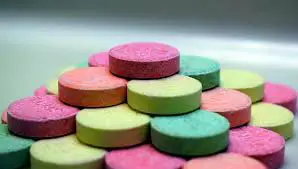The term “organoleptic” refers to the ability to perceive and evaluate sensory properties through our sensory organs, such as taste, smell, texture, and color. In Pharmaceutical drug manufacturing, organoleptic agents are added to pharmaceutical formulations to enhance their sensory qualities to improve patient acceptability. In other words, Organoleptic agents in pharmaceutical aids are the components that have no therapeutic value, but these are essential to formulate any drugs into attractive and acceptable pharmaceutical products.

This article explores the importance of organoleptic agents in pharmaceutical drug manufacturing, their role, types, safety considerations, common examples, challenges, etc.
Organoleptic agents:
Organoleptic agents with Examples are classified as below:
- Color/ Coloring agents:
- Flavors/ Flavoring agents:
- Sweetening agents:
1. Color/ Coloring agents:
Coloring agents/ Colorants obtained from plants, animals, and mineral sources are particularly used for the purpose of providing colors (drugs and cosmetics). They are used as coloring agents in foods and have other pathological effects.
Coloring agents may be defined as a substance which is used in pharmaceutical industries for imparting colors to drugs. Coloring agents do not have any therapeutic effects, but they are useful for product identification during manufacturing and distribution and by the patients during consumption. All coloring agents used in pharmaceutical formulations must be approved and certified by the FDA as per the Drug and Cosmetic Act of 1940.
Types of Colorants:
Mineral colors: These colors are generally obtained from the mineral source. These colors are generally called pigments. These are used to color preparation for external use like; Lotion and cosmetics. Examples; red and ferric oxides, TiO2, carbon black, and lead chromate.
Plant colors: These are obtained from plant sources or by extraction from plants. Examples; Rutin, Riboflavins -> Flavnes, hesperidin, saffron alizarin reddish yellow, Chlorophyll, β- carotene, and Alizarin.
Animal colors: These colors are obtained from animal sources for example; Carminic acid, a bright red coloring agent is present in cochineal, Coccus cacti- which is obtained from the insect, Tyrian blue which is obtained from snails. These are also used as synthetic colorants.
Synthetic colors: In the early days, aniline was used for the preparation of synthetic colors. since all the synthetic colors are not fit for human consumption. Examples include caramel, Coaltar dyes, lake dyes, and Coal for colors- Amaranth, green-s, arange-G, etc.
All coloring agents used in the pharmaceutical formulation must be approved and certified by the FDA and as per the Drug and Cosmetic Act 1940.
Application of coloring agents:
- Coloring agents provide a suitable color for formulation and help in the identification.
- Increase consumer acceptance.
2. Flavors/ Flavoring agents:
Flavoring agents are usually used to mask the saline, bitter, and sour taste sensations. A flavoring agent is required to increase patient acceptance. They are generally used in a solid dosage form such as chewable tablets, syrups, antacids, vitamins, and antibiotics.
Flavoring agents are used in the concentration of 0.5- 0.75%. They are usually stored at 15 to 30 degrees Celsius. In pediatric drugs, flavoring agents play a very important role.
Flavoring agents are mainly used for masking the unpleasant or unacceptable odor from the formulation and providing a more pleasant test or flavor. Flavoring agents are more sensitive to heat ( Thermolabile nature), so they can not be added prior to an operation involving heat, they are often mixed with the granules as an alcohol solution. In the market, many coating tablets are present for masking the flavor.
Classification of Flavouring agents:
Flavoring agents are classified into two categories:
- Natural Flavoring agents: Natural flavoring agents like citrus fruit (Lamon, Orange), Spice (Cinnamon, Peppermint, Ginger, onion), and fruits (apple, Banana).
- Synthetic flavoring agents: Benzaldehyde, cinnamic aldehyde, coumarin, ethyl methyl ketone.
Application of Flavoring agents:
Applications of the Flavouring agents include the following:
- Masking the unpleasant taste or flavor and providing suitable flavor during the preparation of the formulation.
- Increase consumer acceptance.
- Due to flavoring agents taste buds are active rapidly and secrete the digestive enzymes and help the digestion.
3. Sweetening agents:
Sweetening agents or sweeteners are mainly used for masking the undesirable or bitter taste of any drug formulation and increasing the patient’s acceptance of the pharmaceutical dosage form. If talk about pediatric dosage form, it is widely used because children prefer sweetening tests.
In homeopathic medication, small sugar pills are used during the drug delivery. Recently it has been widely used in Ayurvedic medicine also.
Classification of sweetening agents:
Sweetening agents are classified into two categories:
- Natural sweetening agents: Glucose, Fructose, Sucrose. Dextrose and sorbitol.
- Artificial coloring agents: Sucralose, aspartame, and Saccharin.
Sweeteners are also classified into Caloric and Non-Caloric (For Diabetic Patients) as per the table below:
| Sweetener | Caloric/Non-Caloric | Usage |
| Table Sugar (Sucrose) | Caloric | Cooking, baking, beverages, general sweetening |
| High-Fructose Corn Syrup (HFCS) | Caloric | Processed foods, soft drinks, condiments |
| Honey | Caloric | Beverages, desserts, sauces, general sweetening |
| Agave Syrup | Caloric | Baking, beverages, dressings |
| Maple Syrup | Caloric | Pancakes, waffles, baking, general sweetening |
| Aspartame | Non-Caloric | Diet sodas, sugar-free gum, certain desserts |
| Stevia | Non-Caloric | Beverages, desserts, tabletop sweetener |
| Sucralose | Non-Caloric | Baked goods, dairy products, soft drinks |
| Saccharin | Non-Caloric | Beverages, desserts, sugar substitutes in recipes |
| Monk Fruit Extract | Non-Caloric | Beverages, desserts, sugar substitutes in recipes |
Application of sweetening agents:
- Sweetening agents mask the undesirable or bitter taste.
- Increase consumer acceptance.
Conclusion:
Organoleptic Agents have nothing to do with active pharmaceutical ingredients, However, they do enhance the properties of the drugs.


